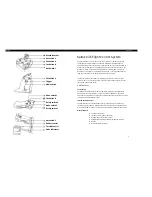
Page
8
of
36
switching on the stirrer / ventilator operation for a strictly defined time,
independently whether the control work of the controller is switched on.
6.
The chiller (unit) operation supervision function, consisting in the possibility of setting
the maximum and the minimum operation time of the chiller, as well as the minimum standstill
time of the chiller – parameters E1 and E2.
7.
Registering the maximum and minimum temperature values in the whole cycle of the
controller's operation. This function is connected with the possibility of delaying the saving
of temperature data to the controller's memory since its activation – parameter AA.
8.
The function of alarm signaling (visual and audible) of exceeding the set temperature range –
parameters HA and HE. This function is connected with the possibility of delaying the time
of switching on the alarm system of the controller from the moment of its activation.
9.
Temperature monitoring and signaling function of the temperature sensor – in this case,
the letters ACU appear on the display.
10.
The function of the adjustable delay time for switching on the chiller (unit) and stirrer after
the loss and re-supplying of the voltage – parameter dE.
11.
Real-time clock.
3.3. Programming for the cooling segment.
In order to ensure the correct cycle of the controller's operation, it is necessary to program its
operating parameters accordingly. By default, the controller is programmed for standard operating
conditions for the purpose of controlling the milk cooler.
In order to change the default programming, enter the setting mode. Entering the setting mode is
possible only when the cooling process is on; interrupts the current operation of the cooling process.
Entering is done by holding the button marked with the letter S for approx. 17 seconds. After
entering the setting mode, UCO appears on the controller's display. The next pressing of the S button
confirms the willingness to make changes. Then press the
▲
key to enter the access code and
confirm with the S button.
After correct entry into the setting mode, the symbol of the required parameter is selected using
the
▲
and
▼
buttons. The entry to the parameter settings is made by pressing the S button.
The change of the parameter value is made using the
▲
and
▼
buttons; for the change to be saved,
confirm with the S button.
The exit from the setting mode is made by setting the EE parameter and confirming with the S button
or automatically after 17 seconds of inactivity.
The following figure illustrates the programming procedure:









































